1. Experimental task 1
The program task1.asm source code and running screenshot are given
assume cs:code, ds:data data segment x db 1, 9, 3 len1 equ $ - x y dw 1, 9, 3 len2 equ $ - y data ends code segment start: mov ax, data mov ds, ax mov si, offset x mov cx, len1 mov ah, 2 s1:mov dl, [si] or dl, 30h int 21h mov dl, ' ' int 21h inc si loop s1 mov ah, 2 mov dl, 0ah int 21h mov si, offset y mov cx, len2/2 mov ah, 2 s2:mov dx, [si] or dl, 30h int 21h mov dl, ' ' int 21h add si, 2 loop s2 mov ah, 4ch int 21h code ends end start
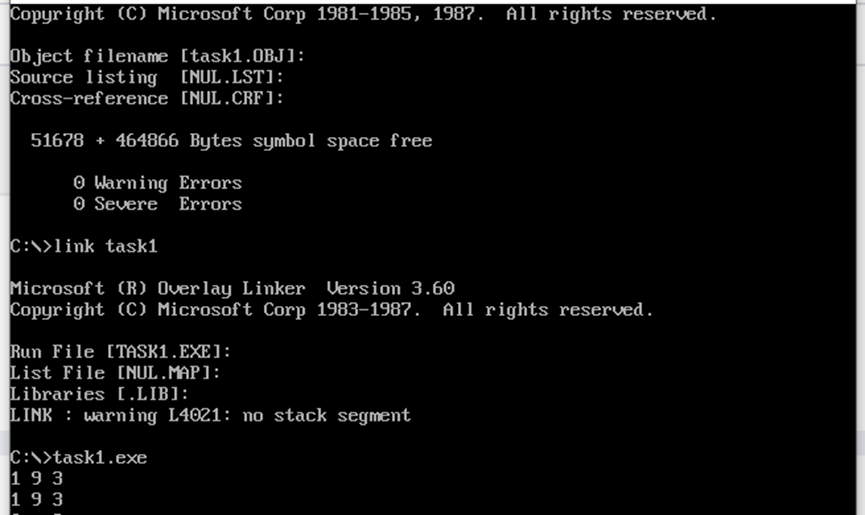
① line27, when the assembly instruction loop s1 jumps, it jumps according to the displacement. Check the machine code through debug disassembly and analyze the jump displacement? (the displacement value is answered in decimal) from the perspective of the CPU, explain how to calculate the offset address of the instruction after the jump label s1.
-14
Cpu executes E2F2, which is the complement of decimal-14, that is, ip moves 14 bytes forward to 076B:000D.
② line44. When the assembly instruction jumps, it jumps according to the displacement. Check the machine code through debug disassembly and analyze the jump displacement? (the displacement value is answered in decimal) from the perspective of the CPU, explain how to calculate the offset address of the instruction after the jump label s2.
-16
Cpu executes e2f0, which is the complement of decimal-16, that is, ip moves 16 bytes forward to 076B:000D.
③ Attach the disassembly screenshot of debugging observation in debug during the above analysis
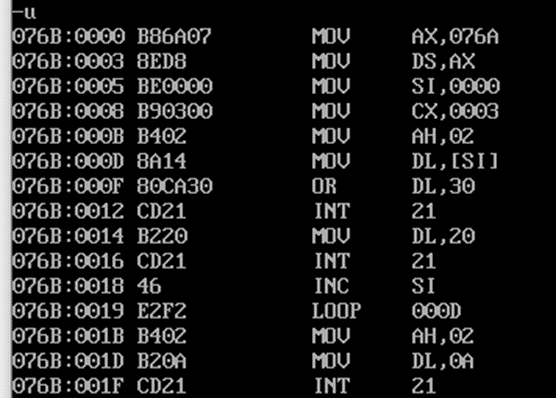
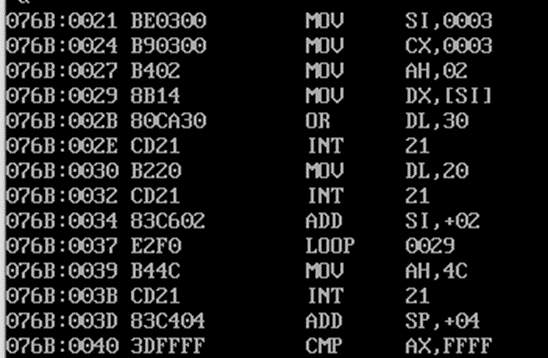
2. Experimental task 2
The program task2.asm source code is given
assume cs:code, ds:data data segment dw 200h, 0h, 230h, 0h data ends stack segment db 16 dup(0) stack ends code segment start: mov ax, data mov ds, ax mov word ptr ds:[0], offset s1 mov word ptr ds:[2], offset s2 mov ds:[4], cs mov ax, stack mov ss, ax mov sp, 16 call word ptr ds:[0] s1: pop ax call dword ptr ds:[2] s2: pop bx pop cx mov ah, 4ch int 21h code ends end start
① According to the jump principle of call instruction, it is analyzed theoretically that before the program executes to exit (line31), register (ax) =? Register (bx) =? Register (cx) =?
Register (ax) = 0021H register (bx) =0026H Register (cx) =076CH

② Assemble and link the source program to get the executable program task2.exe. Use debug to observe and verify whether the debugging results are consistent with the theoretical analysis results.
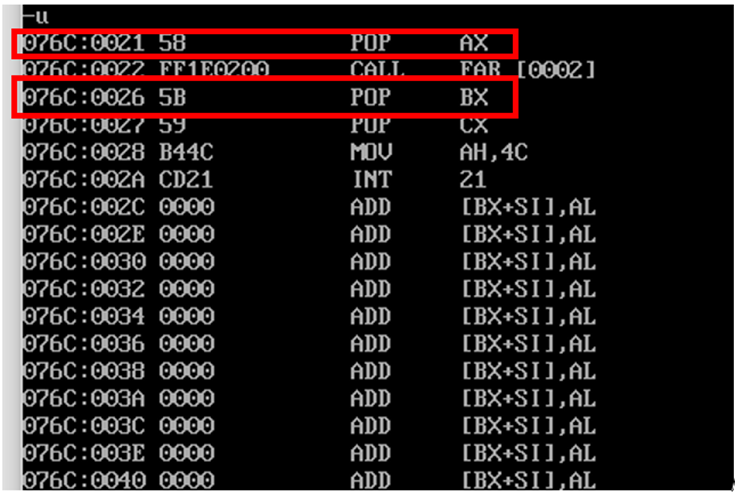
call word ptr ds:[0] assign ip stack to AX, so it is 0021H in AX
call dword ptr ds:[2] put cs and IP on the stack, and then assign the value in cs to CX and IP to bx. Therefore, 0026 in bx and 076C in Cx
3. Experimental task 3
The program source code task3.asm is given
assume cs:code, ds:data data segment x db 99, 72, 85, 63, 89,97,55 len equ $ - x data ends code segment start: mov ax, data mov ds, ax mov si, offset x mov cx, len s1: mov ah,0 mov al,[si] push ax call printNumber call printSpace pop ax inc si loop s1 mov ah, 4ch int 21h printNumber: mov bl,10 div bl mov bx,ax mov ah,2 or bl, 30h mov dl,bl int 21h or bh, 30h mov dl,bh int 21h ret printSpace: mov ah,2 mov dl, ' ' int 21h ret code ends end start
Screenshot of running test

The experiment requires that the output is two digits, that is, after being divided by 10, the remainder and quotient represent one digit and ten digits respectively. Although the above code can meet the experimental requirements, it is not applicable if it is three digits or more. In this case, it is necessary to increase the cycle, press the remainder of each division into the stack, and then output one by one.
4. Experimental task 4
The program source code task4.asm is given
assume cs:code, ds:data data segment str db 'try' len equ $ - str data ends code segment start: mov ax,data mov ds,ax mov ax,0b800h mov es,ax mov si,offset str mov bl,2 ;attribute mov bh,0 ;Line number call printStr;Output above green mov si,offset str mov bl,4 mov bh,24 call printStr;Output below red mov ah, 4ch int 21h printStr: mov al, bh mov dl, 0A0h mul dl ;Calculate offset address mov di, ax mov cx,len s: mov al,[si] mov ah,bl mov es:[di],ax inc si add di,2 loop s ret code ends end start
Screenshot of running test
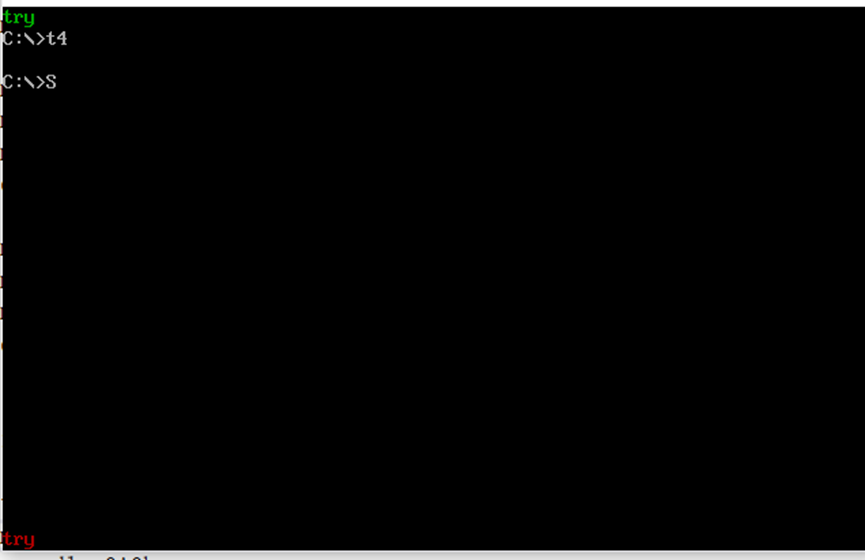
5. Experimental task 5
The program source code task5.asm is given
assume cs:code, ds:data data segment stu_no db '201983290532' len = $ - stu_no data ends code segment start: mov ax, data mov ds, ax mov ax,0B800H mov es,ax mov cx,0780H mov ah,00010000b mov al,' ' mov bx,0 back: mov es:[bx],ax;Output blue background add bx,2 loop back mov cx,80 mov ah,00010111b mov al,'-' vet: mov es:[bx],ax;Output all of the last row'-' add bx,2 loop vet mov cx,len mov bx,0F44H mov si,0 letter: mov al,[si];Output student number mov es:[bx],ax inc si add bx,2 loop letter mov ah, 4ch int 21h code ends end start
Screenshot of running test
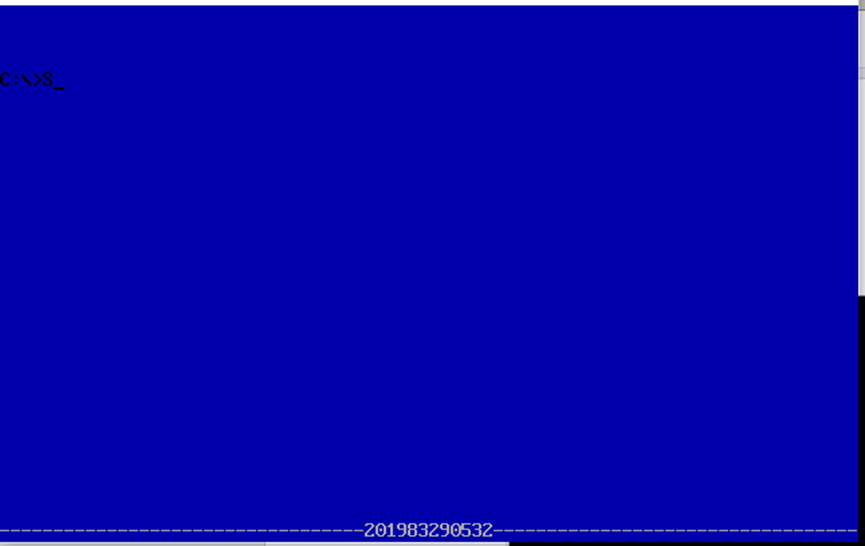
When outputting the student number, the offset address is 0f44h calculated by yourself. If it is more complete, the offset address should be obtained by multiplying the line number of 25-1 = 24 by 160 characters and adding [(80-12) / 2] 16.